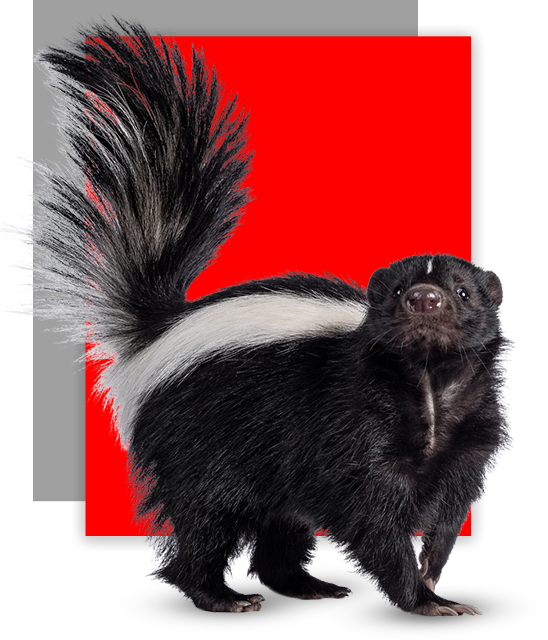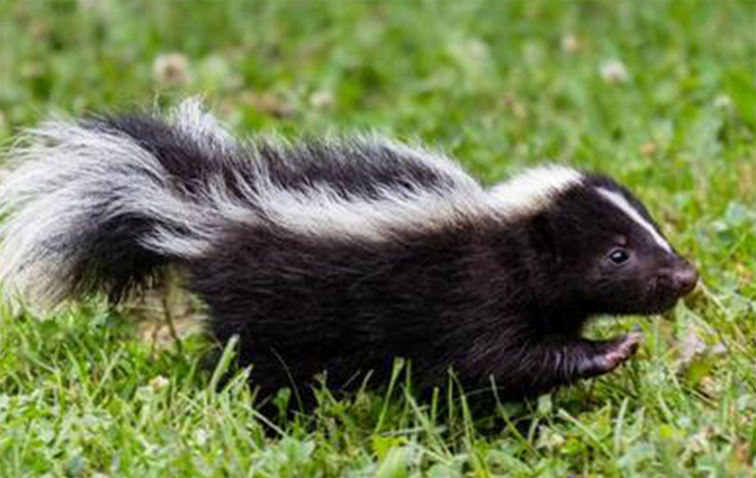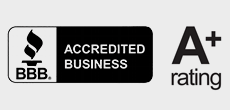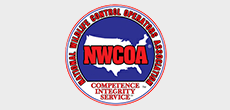
Skunks often choose to den underneath homes and will dig cone-shaped holes in the yard – looking for grubs. Plus, there’s no doubt about it, simply the smell of their odor lets you know of their proximity!
Of all the animals regarding which Trapping USA receives removal requests, perhaps none is preceded by its reputation quite like the skunk. It is so well-known for its malodorous defensive spray, that many people are unfamiliar with any of its other characteristics.
For this reason, many people who attempt to eliminate a presence of skunks in their area end up only worsening the problems these animals bring with them. Trapping USA has developed a comprehensive knowledge base with which to develop a system allowing us attack the problem of skunk infestations with speed and efficiency. We know what to look for, and how to address whatever is found. Our process is furthermore backed up by a guarantee ensuring that our work remains effective even in the future. We are able to to offer this guarantee due to our knowledge and experience with skunks; we are aware of all the factors that other people may not be.

The second most recognizable aspect of a skunk, and one with which almost everyone is still familiar, is its high-contrast appearance. In the days of fur trapping, the animal was prized for its long, soft, and glossy coat. But while the skunk’s highly visible black and white appearance is not meant to impart an idea of beauty to other animals, it is meant to be highly visible.
This is basically because a skunk’s anal scent glands can only hold enough chemical in reserve to spray half a dozen times. As such, a skunk will generally only use this defense as a last resort. When first faced with a potential threat, skunks will hiss, stamp their feet, or perform deimatic postures to scare it off. If the threat remains despite these attempts, the skunk will then release its infamous spray. It takes about ten days for the skunk to replenish its supply of the spray.
The skunk’s coloration goes hand-in-hand with this threat posturing, and the general reluctance it demonstrates towards relying on the spray for defense. The starkly contrasted black and white pattern skunks display is an example of an aposematic signal; it serves to alert predators that the skunk is to be avoided. Since it is easier to avoid a predator that never sees you in the first place than it is to be forced to flee from it, most animals make use of camouflage as a defense mechanism. However, possessing a potent deterrent has allowed the skunk to evolve coloration that alerts predators it is unlike other prey, and has no need to hide itself from them. This alone lowers the danger skunks have to face in the wild.
And a potent deterrent it is. Skunks can use their spray to ward off attacks from numerous types of predators, including foxes, badgers, coyotes, wolves, and even smaller bears. An array of muscles around their anal scent glands allows them to spray with a high degree of accuracy to a distance ten feet. This is especially useful because the spray is not only foul-smelling, but contains irritant compounds as well, and has been known to even cause temporary blindness.
As a result, the skunk is safe from the majority of predators. It has been well-documented that predators in the USA will generally avoid skunks whenever possible. The groups of animals known to attack skunks fall into only a few categories; the first is any individual animal that hasn’t encountered skunks before, or for whatever reason hasn’t developed an aversion towards them. Occasionally an animal will attack a skunk, but its attack is almost always stopped dead in its tracks. Even if the predator does manage to kill the skunk, it is unlikely to ever approach another one afterwards.
The second category is domesticated dogs, particularly of the sporting or terrier varieties. Because these dogs are generally bred with strong pursuit and prey instincts, they will generally react to the sight of a skunk with extreme and immediate aggression. Even if the skunk does manage to spray them before they reach it, they will often end up injuring the skunk at bare minimum regardless.
The third category, which is also the only truly significant one, is the great horned owl. This particular species of owl native to the Americas is, in fact, the skunk’s one and only regular predator. More than anything else, this fact speaks to the effectiveness of the skunk’s defense mechanisms in the wild.
Perhaps it is for these reasons that skunk infestations occur so frequently. Being an omnivorous and generally fearless animal, skunks infiltrate human areas without a second thought. And the presence of a skunk infestation is a problem in more ways than one.

Shallow, conical holes in the ground a couple of inches across, made in search of food
Much deeper holes with an entrance of about eight inches, especially those near foundations, woodpiles, overgrown grasses, piles of rocks or leaves, hen houses, etc.
Torn-open trash bags or garbage bins
Empty pet food bowls outside, in the garage, or in the basement
And, of course, the smell; if you have never smelled skunk spray before, its sulfur compounds give a smell similar to rotten eggs, burned rubber, and garlic
The smartest home and business owners, call Trapping USA of Dallas, a Texas skunk specialist will take care of your nuisance skunk problem and assume the risk of smelling as bad as a skunk! But if that isn’t enough to convince you, keep in mind that skunks are a significant carrier of rabies in the United States. Plus, their tendency to settle in urbanized areas makes them a double threat to you and your family or coworkers. Skunks can carry parasites that include leptospirosis and an intestinal roundworm called baylisascaris columnaris; these diseases, in addition to distemper, canine hepatitis, fleas, ticks, lice and mites can be transferred from skunks to your pets causing serious harm and/or death.
We service residential and commercial customers throughout North Texas in towns such as Addison, Allen, Arlington, Carrollton, The Colony, Dallas, Flower Mound, Frisco, Garland, Grand Prairie, Grapevine, Irving, Lewisville, McKinney, Plano, Prosper, Richardson, Rockwall, Rowlett and more!
If you suspect you have a bird problem and you are in need of help removing birds, contact Trapping USA by calling (469) 481-6552 in North Texas, (832) 474-7755 in Houston or contact us online to inquire about our wildlife and animal removal services.
Contact Trapping USA for expert animal control services.




Dallas AREAS
Dallas AREAS
HOUSTON AREAS
HOUSTON AREAS